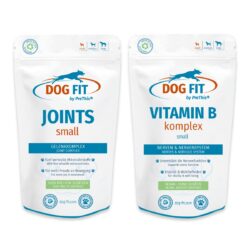Herniated disc in dogs
Intervertebral Disc Herniation – Causes and Symptoms
A herniated disc in dogs is usually caused by age-related wear and tear or excessive strain on the spine. The intervertebral discs lose their elasticity, dry out, and can shift or bulge. Dog breeds with long backs, such as dachshunds, Pekingese, or cocker spaniels, are particularly affected. Obesity, insufficient exercise, and a consistently unbalanced, dry diet can also contribute to the wear and tear of the intervertebral discs.
Symptoms of a Herniated Disc
The symptoms of a herniated disc in dogs range from back pain, restricted mobility, and changes in gait to neurological deficits. These include tremors, paralysis, incontinence, paw dragging, or balance problems. The dog may avoid stairs, no longer jump into the car, or display a hunched posture. Depending on the severity, prompt veterinary evaluation is necessary. An MRI or CT scan can provide clarity and rule out other conditions such as spondylosis or HD.
Therapeutic Approaches and Conservative Treatment
The goal is to relieve pain, reduce inflammation, and stabilize damaged structures. In addition to veterinary-prescribed painkillers, physiotherapy measures such as massages, underwater treadmills, or targeted exercise therapy can also help. Rest, a soft surface to lie on, and a daily routine that is gentle on the back are also important for a herniated disc in dogs.
Role of Micronutrients
Micronutrients play a valuable role in supporting the treatment. They support the normal function of the intervertebral discs, nerve pathways, and connective tissue. A comprehensive vitamin B complex has proven effective for nerve function. A combination of glucosamine, MSM, collagen, hyaluronic acid, calcium, and other components is suitable for the supply of intervertebral discs, bones, and surrounding tissues such as tendons, fascia, and ligaments.
Potential Benefits of Targeted Micronutrient Supply
- Supports the normal function of intervertebral discs and vertebrae
- Contribution to physiological impulse transmission in the nerve pathways
- Accompanying care for coordination restrictions or incontinence
- Supports the surrounding tissue for greater stability

